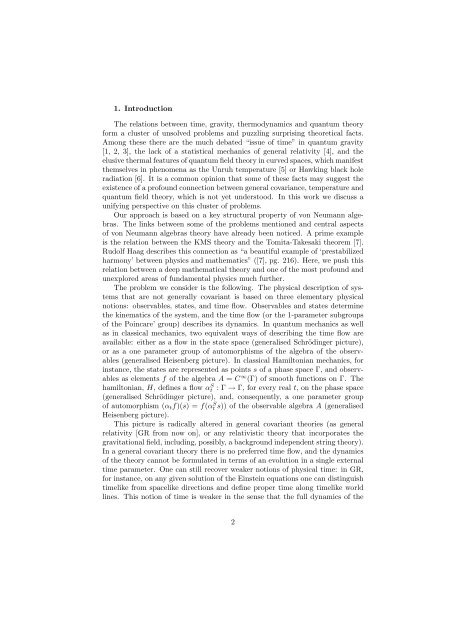Von Neumann algebra automorphisms and time ... - Alain Connes
Von Neumann algebra automorphisms and time ... - Alain Connes
Von Neumann algebra automorphisms and time ... - Alain Connes
You also want an ePaper? Increase the reach of your titles
YUMPU automatically turns print PDFs into web optimized ePapers that Google loves.
1. Introduction<br />
The relations between <strong>time</strong>, gravity, thermodynamics <strong>and</strong> quantum theory<br />
form a cluster of unsolved problems <strong>and</strong> puzzling surprising theoretical facts.<br />
Among these there are the much debated “issue of <strong>time</strong>” in quantum gravity<br />
[1, 2, 3], the lack of a statistical mechanics of general relativity [4], <strong>and</strong> the<br />
elusive thermal features of quantum field theory in curved spaces, which manifest<br />
themselves in phenomena as the Unruh temperature [5] or Hawking black hole<br />
radiation [6]. It is a common opinion that some of these facts may suggest the<br />
existence of a profound connection between general covariance, temperature <strong>and</strong><br />
quantum field theory, which is not yet understood. In this work we discuss a<br />
unifying perspective on this cluster of problems.<br />
Our approach is based on a key structural property of von <strong>Neumann</strong> <strong>algebra</strong>s.<br />
The links between some of the problems mentioned <strong>and</strong> central aspects<br />
of von <strong>Neumann</strong> <strong>algebra</strong>s theory have already been noticed. A prime example<br />
is the relation between the KMS theory <strong>and</strong> the Tomita-Takesaki theorem [7].<br />
Rudolf Haag describes this connection as “a beautiful example of ‘prestabilized<br />
harmony’ between physics <strong>and</strong> mathematics” ([7], pg. 216). Here, we push this<br />
relation between a deep mathematical theory <strong>and</strong> one of the most profound <strong>and</strong><br />
unexplored areas of fundamental physics much further.<br />
The problem we consider is the following. The physical description of systems<br />
that are not generally covariant is based on three elementary physical<br />
notions: observables, states, <strong>and</strong> <strong>time</strong> flow. Observables <strong>and</strong> states determine<br />
the kinematics of the system, <strong>and</strong> the <strong>time</strong> flow (or the 1-parameter subgroups<br />
of the Poincare’ group) describes its dynamics. In quantum mechanics as well<br />
as in classical mechanics, two equivalent ways of describing the <strong>time</strong> flow are<br />
available: either as a flow in the state space (generalised Schrödinger picture),<br />
or as a one parameter group of <strong>automorphisms</strong> of the <strong>algebra</strong> of the observables<br />
(generalised Heisenberg picture). In classical Hamiltonian mechanics, for<br />
instance, the states are represented as points s of a phase space Γ, <strong>and</strong> observables<br />
as elements f of the <strong>algebra</strong> A = C ∞ (Γ) of smooth functions on Γ. The<br />
hamiltonian, H, defines a flow α S t : Γ → Γ, for every real t, on the phase space<br />
(generalised Schrödinger picture), <strong>and</strong>, consequently, a one parameter group<br />
of automorphism (αtf)(s) = f(α S t s)) of the observable <strong>algebra</strong> A (generalised<br />
Heisenberg picture).<br />
This picture is radically altered in general covariant theories (as general<br />
relativity [GR from now on], or any relativistic theory that incorporates the<br />
gravitational field, including, possibly, a background independent string theory).<br />
In a general covariant theory there is no preferred <strong>time</strong> flow, <strong>and</strong> the dynamics<br />
of the theory cannot be formulated in terms of an evolution in a single external<br />
<strong>time</strong> parameter. One can still recover weaker notions of physical <strong>time</strong>: in GR,<br />
for instance, on any given solution of the Einstein equations one can distinguish<br />
<strong>time</strong>like from spacelike directions <strong>and</strong> define proper <strong>time</strong> along <strong>time</strong>like world<br />
lines. This notion of <strong>time</strong> is weaker in the sense that the full dynamics of the<br />
2


